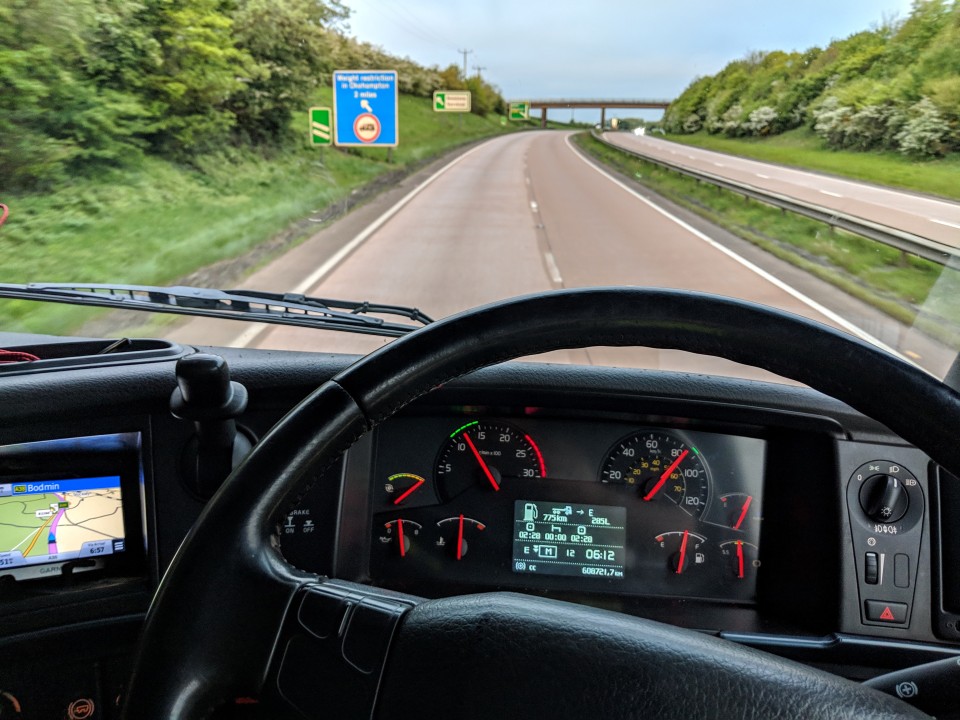
Susie Jones
Nudíte se na cestách?
Vytvořeno: 27.08.2024
•
Aktualizováno: 27.08.2024
Průměrný řidič nákladního vozidla stráví za volantem zhruba 12 hodin denně. Nekonečný čas na otevřené silnici může znít lákavě, ale realita je v ostrém kontrastu. Nesčetné čerpací stanice, odpočívadla a dlouhé hodiny mohou být únavné. Řidiči kamionů často tráví prostoje mimo domov a zabránit nudě může být náročné.
Nedávný průzkum společnosti Convoy ukázal, že jedním z hlavních problémů řidičů kamionů je nuda. Jaký vliv má nuda na pohodu řidičů? A jak se mohou řidiči kamionů zabavit?
Jak nuda ovlivňuje pohodu řidiče
Únava, izolace, osamělost a nedostatek duševní stimulace jsou častými problémy řidičů. Někteří řidiči mohou tyto obavy řešit nezdravými mechanismy zvládání - například přejídáním, kouřením nebo nadměrnou konzumací kofeinu. Tyto návyky mohou časem negativně ovlivnit duševní zdraví.
S tím, jak se zlepšují diskuse o duševním zdraví, se však stále více řidičů vydává jinou cestou boje. Na Facebooku jsme se zeptali řidičů kamionů, co dělají, když je přepadne nuda.
"Audioknihy, hlavně psychologie. Hudba, povídání s blízkými nebo poslech rádia. Nebo všechno vypnu a v klidu existuji se svými myšlenkami," říká Nigel.
Jiní se zmiňují o tom, že jim pomohl telefonický rozhovor s blízkými. Ashleigh uvádí:
"Mluvím s přáteli ve skupinovém chatu. Upřímně řečeno, kdybych je neměl, už bych dávno skončil. Cesta vyvrací některé nesmysly a bez povídání s opravdu dobrými přáteli bych to nikdy nepřežil."
Stejně tak Karl věří, že "skupinový chat s přáteli je nutností".

Prevence nudy za volantem
Navzdory všeobecnému přesvědčení je řízení nákladního vozidla fyzicky náročné - řidiči potřebují koordinaci a soustředění, aby se vyhnuli nehodám. Přesto může dlouhodobý pobyt za volantem způsobit únavu. Může dojít k riziku, že řidič při práci poleví, zejména pokud dobře zná svou trasu. Jak se mohou řidiči vypořádat se sebeuspokojením za volantem?
Ať už jde o poslech podcastu nebo chytlavé melodie, řidiči si musí vybrat něco, co udrží jejich mysl ve střehu. Sestavili jsme seznam věcí, které zabrání nudě za volantem.
Podcasty: Řidič kamionu Marty poslouchá během jízdy "desítky podcastů". Podcasty jsou skvělým způsobem, jak si zpestřit jízdu a naučit se něco nového. Podívejte se na tento užitečný seznam podcastů pro kamionovou dopravu.
Hudba: "Hudba, hudba a zase hudba" je Richardovým prostředkem k zahnání nudy. Ať už jde o poslech rádia nebo zpívání podle playlistu, hudba je vynikajícím způsobem, jak udržet mysl ve střehu.
Udělejte si přestávku: Přestože řidiči mají přísné termíny a předpisy pro tachografy, vystoupení z kabiny, když se nudí, pomáhá mysli znovu se soustředit.
Nuda během prostojů
Řidiči kamionů čelí dalším výzvám, jak se po směně zabavit. Aktivní přístup k prevenci nudy během této doby je nezbytný. Sestavili jsme seznam způsobů, jak si ukrátit dlouhé chvíle.
Umístění: Zastávky kamionů, které nabízejí širokou škálu zařízení a společnou atmosféru, jsou vynikajícím způsobem, jak zmírnit nudu. Některá fungují jako společenské centrum, kde mohou řidiči kamionů sdílet podobné zážitky. Přejděte na naši stránku lokality a podívejte se, jaká zařízení nabízejí naši servisní partneři SNAP.
Cvičení: Cvičení: Každodenní procházky nebo kreativní cvičení mohou zabránit nudě a zajistit, že zůstanete fit a zdraví. Podívejte se na naše tipy, jak zůstat zdravý na cestách
Streamovací služby: Sledujte nejnovější televizní pořad nebo procházejte sociální média. Řidič kamionu Steve rád "projíždí a komentuje Facebook a sleduje Netflix", aby si ukrátil čas.
Koníčky: Příležitostí je nepřeberné množství. Učení se na hudební nástroj, cizí jazyk, kreslení, psaní a další. Vybrat si koníček je účinný způsob, jak zabránit nudě.
Vaření: Vaření v kabině má mnoho výhod. Nejenže se při něm nenudíte, ale také ušetříte peníze a je zdravější.
Zůstaňte ve spojení se svými blízkými: Prostoje řidičů kamionů jsou ideální příležitostí ke kontaktu s jejich nejbližšími. Videohovory jsou účinným způsobem, jak se sblížit s rodinou a přáteli.
Uvolněte se: Řidiči kamionů mohou čelit stresovým situacím. Úplná relaxace po směně může zlepšit pohodu řidiče. Relaxační techniky, jako jsou hluboká dechová cvičení a meditace, snižují stres.
Přestože si někteří řidiči užívají samotu a nezávislost, kterou jim otevřená silnice nabízí, pro mnohé je boj s nudou stále výzvou. Vzhledem k povaze práce zažívají řidiči kamionů často dlouhá období nudy. Pro zlepšení pohody, spokojenosti s prací a bezpečnosti silničního provozu však musí najít způsoby, jak ji zmírnit. Ať už je to soustředění se na daný úkol, poslech rádia nebo povídání si s přáteli a rodinou, většina řidičů kamionů dokáže najít řešení, které jim vyhovuje.

Kde spí řidiči kamionů?
Většina řidičů spí ve svých kabinách, protože jsou dobře vybaveny pro pohodlný spánek. Základní lůžková kabina obsahuje lůžko, úložné prostory, světla a elektrické zásuvky - je to tedy domov daleko od domova.
Kvůli současnému nedostatku parkovacích míst v Evropě mnoho řidičů parkuje na odstavných plochách. Takové parkování je považováno za nebezpečné a řidič je vystaven nebezpečí krádeže. Od listopadu 2017 musí řidiči nákladních vozidel ve Spojeném království pravidelně každý týden využívat přestávky na odpočinek na vhodných odpočívadlech (jako jsou servisní zóny a zastávky pro nákladní vozidla).
Systém SNAP's Depot Parking umožňuje vozovým parkům nabídnout svá parkovací místa pro nákladní automobily do sítě, čímž se zmírní jejich nedostatek a řidiči se vyhnou rizikovým situacím. Kromě toho SNAP poskytuje řidičům k parkování více než 450 servisních partnerů po celé Evropě. Více informací najdete na stránce mapy.
Proč nechávají řidiči kamionů otevřené dveře přívěsu?
Pokud jste někdy jeli v noci po hlavní silnici, možná jste si všimli nákladních aut zaparkovaných s otevřenými dveřmi přívěsu. Mnoho řidičů to dělá proto, aby odradili zloděje, protože předpokládají, že pokud jsou dveře přívěsu otevřené, není co ukrást. To se dělá převážně u přívěsů s plachtou, protože to zlodějům brání rozříznout plachtu, aby viděli, co je uvnitř.



